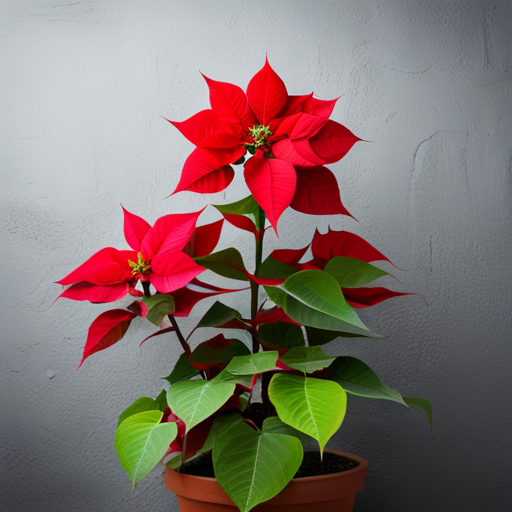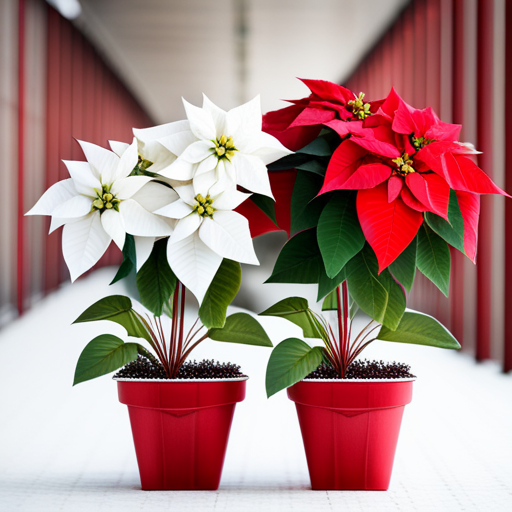
As the holiday season approaches, the poinsettia plant is a staple in homes across the country. With its vibrant red and green foliage, it’s no wonder that the poinsettia has become synonymous with Christmas. However, many people struggle with keeping their poinsettias alive throughout the season. In this blog post, I will share with you everything you need to know about how to care for a poinsettia plant.
How to Care for Poinsettias Indoors
Caring for poinsettias indoors involves a few crucial steps.
- Light and Temperature: Poinsettias thrive in bright, indirect sunlight and prefer temperatures between 65-75°F (18-24°C). Avoid placing them near drafts, fluctuating temperatures, or excessive heat sources like fireplaces or radiators.
- Watering: Overwatering is a common mistake. Water your poinsettia when the top inch of soil feels dry to the touch. Drain any excess water from the saucer to prevent root rot.
- Humidity: Poinsettias enjoy high humidity. You can increase the humidity around your poinsettia by placing it on a tray of pebbles filled with water.
- Fertilizing: While poinsettias don’t require frequent fertilizing, a balanced all-purpose houseplant fertilizer can encourage lush growth. Apply it once a month, except during blooming.
- Pruning: After the blooming season, prune the plant back to about 6 inches from the top of the pot to encourage new growth.
Armed with these tips, your poinsettia can remain a vibrant and festive highlight in your home throughout the holiday season.
How to Care for Poinsettias Outdoors
When it comes to caring for poinsettias outdoors, the process is slightly different but no less important.
- Location: Choose a spot that gets plenty of morning sun but is protected from hot afternoon rays. Poinsettias can burn in harsh, direct sunlight.
- Soil: Plant your poinsettia in well-draining soil to prevent waterlogging. A high-quality garden soil mix will usually suffice.
- Watering: Outdoor poinsettias need to be watered more frequently than indoor ones due to higher evaporation rates. Water whenever the top inch of soil becomes dry.
- Fertilizing: Feed your outdoor poinsettia regularly with a balanced, all-purpose garden fertilizer to support its growth. Fertilize once a month, except during blooming.
- Winter Care: Poinsettias are not frost-tolerant. If temperatures in your area drop below 50°F (10°C), consider bringing your plant indoors or provide a protective cover.
These strategies will ensure your outdoor poinsettia plant will flourish and provide a joyful burst of color for your garden or yard during the festive season.
What Zone Can You Plant Your Poinsettia Outdoors and How to Care for Them?
Poinsettias are native to Mexico and Central America, which means they are most at home in USDA Hardiness Zones 9 to 11 where the climate is warm throughout the year. If you live within these zones, you can grow poinsettias outdoors all year round.
If you’re in a colder zone, you’ll need to treat your poinsettia as an annual or bring it indoors during the winter. Freeze and frost can severely damage or even kill a poinsettia plant, so it’s crucial to monitor weather forecasts closely. If frost is predicted, consider moving your poinsettia to a more secure location or covering it with a frost blanket.
While caring for your outdoor poinsettia in these zones, follow the same basics as discussed before — proper location selection, soil preparation, watering, fertilization, and winter care. But also remember to pay attention to local pests that could pose a threat to your plant. If pests become a problem, consider using a gentle, plant-friendly pesticide. Ultimately, with a little bit of care and attention, you can enjoy the vibrant colors of your poinsettia throughout the year, no matter the zone you’re in.
How Long do Poinsettias Live?
Under ideal conditions, the vibrant foliage of a poinsettia can last for several weeks, or even months, typically from November through March. The lifespan of a poinsettia is largely dependent on how well it is cared for. However, it’s important to note that poinsettias are perennial plants, meaning they can live for more than two years with proper care.
After the holiday season is over, you may wonder if your poinsettia will survive and bloom again for the next holiday season. The answer is yes, but it requires some effort. By following appropriate watering, light, temperature, and pruning guidelines as mentioned earlier, you can help your poinsettia rejuvenate for another blooming season.
In their native tropical climate of Mexico and Central America, poinsettias can grow into large shrubs or small trees that bloom each winter. This might not be achievable in your living room or garden, but with the correct care, your poinsettia can certainly be encouraged to bloom again. Remember, patience and persistence are key!
How to Get Poinsettia to Rebloom
Getting your poinsettia to rebloom may seem intimidating, but with a little patience and care, it can be a rewarding process.
- Rest Period: After the blooming season ends around March, gradually reduce watering to encourage a rest period. The leaves will likely wilt and fall off, but don’t worry, this is part of the process. Continue to keep the plant in a cool, light location.
- Re-watering and Fertilizing: In late spring, return to regular watering and fertilize the plant once every two weeks with a balanced all-purpose houseplant fertilizer. Ensure the plant receives plenty of indirect sunlight.
- Re-potting (if necessary): If your poinsettia has outgrown its container, this is the time to re-pot it. Choose a new pot that is no more than 4 inches larger in diameter than the current one.
- Controlled Lighting: Poinsettias need long periods of darkness to encourage blooming. Starting in early October, keep the plant in complete darkness for 14 continuous hours each night. This can be done by moving it into a dark room or covering it with a box.
- Regular Care: After 8 weeks of this light control treatment, you can stop. Continue caring for your poinsettia as before, ensuring it gets adequate light, water, and humidity.
How to Propagate Poinsettia
Propagating poinsettias can be a fun and rewarding process — it’s a great way to multiply your beautiful plants without buying new ones. Here are the steps to follow:
- Choosing Cuttings: Choose healthy, mature poinsettia plants to take cuttings from. Look for stems that are mature, firm, and not too woody. The best time to take cuttings is in the summer.
- Taking Cuttings: Using a clean, sharp pair of scissors or a knife, make a cut 4-6 inches from the end of the stem. Try to include at least two to three nodes on the cutting.
- Preparation: Remove the lower leaves from the cutting, leaving the top two to four intact. Dip the cut end into a rooting hormone to promote root growth.
- Planting: Plant the cuttings into a pot filled with a mix of peat and perlite, or a good-quality soilless potting mix. Place the cuttings in a warm, bright location, out of direct sunlight.
- Watering and Care: Maintain a high level of humidity around the cuttings by misting them with water daily. Keep the soil lightly moist, but avoid overwatering as this can cause rotting.
- Rooting: With proper care, the cuttings should root in 4-6 weeks. Once they have rooted, you can transplant them into individual pots and continue to care for them as you would a mature poinsettia.
Remember, propagation might not always be successful on the first try, but don’t get discouraged. Patience and persistence can yield beautiful results!
Happy Gardening!

With attention to these details, your poinsettia can be coaxed into reblooming and bring joy for another holiday season.In conclusion, caring for your poinsettia plant doesn’t have to be difficult. By following these five simple steps: choosing the right pot size and soil type, watering correctly, providing adequate light, fertilizing properly, and maintaining the correct temperature and humidity, you can keep your poinsettia plant alive throughout the holiday season and beyond.
Please be sure to check out my Gardening Blog Post Page for more tips on all types of gardening. Including Seed Saving, Seed Starting, Orchids, Water Gardening, Coldframe Gardening, Indoor Bulb Gardening, Hydroponics, Container Gardening, Mums, Herbs, African Violets, planting Bulbs, Flower Gardening, Vegetable and Fruit Gardening, Indoor Houseplants of all kinds, Cactus, Succulents, Hanging plants, Deer resistant plants and even Bird, Bee, Butterfly and Hummingbird Gardens!
